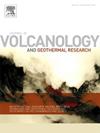Variations in pore structure in subaerial lava flows at Nishinoshima, Japan, inferred from physical properties
IF 2.4
3区 地球科学
Q2 GEOSCIENCES, MULTIDISCIPLINARY
Journal of Volcanology and Geothermal Research
Pub Date : 2025-02-01
DOI:10.1016/j.jvolgeores.2024.108262
引用次数: 0
Abstract
Nishinoshima, a volcanic island in the Izu–Ogasawara arc, Japan, has erupted intermittently since activity restarted in 2013, alternating primarily between effusive lava flows and explosive eruptions. An understanding of pore structure in lava flow clues to the volcanic processes that accompany eruption, including the physical conditions during effusion, the efficiency of gas escape, and seawater circulation within the edifice. We investigated the relationships between various physical properties of the lava flows on Nishinoshima to characterize their internal pore structure. Laboratory measurements of porosity, density, permeability, electrical resistivity, and P-wave velocity were conducted at ambient temperature and atmospheric pressure on andesitic lava blocks collected by land-based surveys conducted in 2016, 2019, and 2021. The measured resistivities and P-wave velocities vary with porosity, although the trends are different in different lithofacies (vesicular, dense, and foliated blocks). By comparing these variations with theoretical models, they can be attributed to differences in connectivity and geometry of pore space in the different lithofacies. These lithofacies-dependent pore structures contribute to the observed variations in permeability, which can vary by as much as five orders of magnitude for a given porosity. The differences in pore structure and permeability may be related to post-eruption processes, where shear deformation during lava flow emplacement flattened and elongated the bubbles, leading to low aspect ratios, smaller apertures, and higher connectivity in the foliated lavas. Our data and interpretations could assist in estimating the internal pore structures at Nishinoshima through geophysical surveys, although further investigation incorporating submarine samples is necessary.
从物理性质推断日本西之岛次生熔岩流孔隙结构的变化
西野岛(Nishinoshima)是日本伊豆-小笠原(Izu-Ogasawara)弧上的一座火山岛,自2013年火山活动重新开始以来,它一直在间歇性喷发,主要是在喷涌的熔岩流和爆炸性喷发之间交替进行。对熔岩流孔隙结构的了解为火山喷发过程提供了线索,包括喷发时的物理条件、气体逸出的效率和大厦内的海水循环。我们研究了西野岛熔岩流的各种物理性质之间的关系,以表征其内部孔隙结构。对2016年、2019年和2021年陆基调查收集的安山岩熔岩块在室温和常压下进行了孔隙度、密度、渗透率、电阻率和纵波速度的实验室测量。测得的电阻率和纵波速度随孔隙度的变化而变化,尽管在不同的岩相(泡状、致密和片理块体)中趋势不同。将这些变化与理论模型进行比较,可以将其归因于不同岩相中孔隙空间连通性和几何形状的差异。这些依赖于岩相的孔隙结构有助于观察到渗透率的变化,对于给定的孔隙度,其变化可达5个数量级。孔隙结构和渗透率的差异可能与喷发后的过程有关,熔岩流侵位过程中的剪切变形使气泡变平并拉长,导致片理熔岩的宽高比低、孔径小、连通性高。我们的数据和解释可以通过地球物理调查来帮助估计西野岛的内部孔隙结构,尽管进一步的调查是必要的,包括海底样本。
本文章由计算机程序翻译,如有差异,请以英文原文为准。
求助全文
约1分钟内获得全文
求助全文
来源期刊
CiteScore
5.90
自引率
13.80%
发文量
183
审稿时长
19.7 weeks
期刊介绍:
An international research journal with focus on volcanic and geothermal processes and their impact on the environment and society.
Submission of papers covering the following aspects of volcanology and geothermal research are encouraged:
(1) Geological aspects of volcanic systems: volcano stratigraphy, structure and tectonic influence; eruptive history; evolution of volcanic landforms; eruption style and progress; dispersal patterns of lava and ash; analysis of real-time eruption observations.
(2) Geochemical and petrological aspects of volcanic rocks: magma genesis and evolution; crystallization; volatile compositions, solubility, and degassing; volcanic petrography and textural analysis.
(3) Hydrology, geochemistry and measurement of volcanic and hydrothermal fluids: volcanic gas emissions; fumaroles and springs; crater lakes; hydrothermal mineralization.
(4) Geophysical aspects of volcanic systems: physical properties of volcanic rocks and magmas; heat flow studies; volcano seismology, geodesy and remote sensing.
(5) Computational modeling and experimental simulation of magmatic and hydrothermal processes: eruption dynamics; magma transport and storage; plume dynamics and ash dispersal; lava flow dynamics; hydrothermal fluid flow; thermodynamics of aqueous fluids and melts.
(6) Volcano hazard and risk research: hazard zonation methodology, development of forecasting tools; assessment techniques for vulnerability and impact.

 求助内容:
求助内容: 应助结果提醒方式:
应助结果提醒方式:


